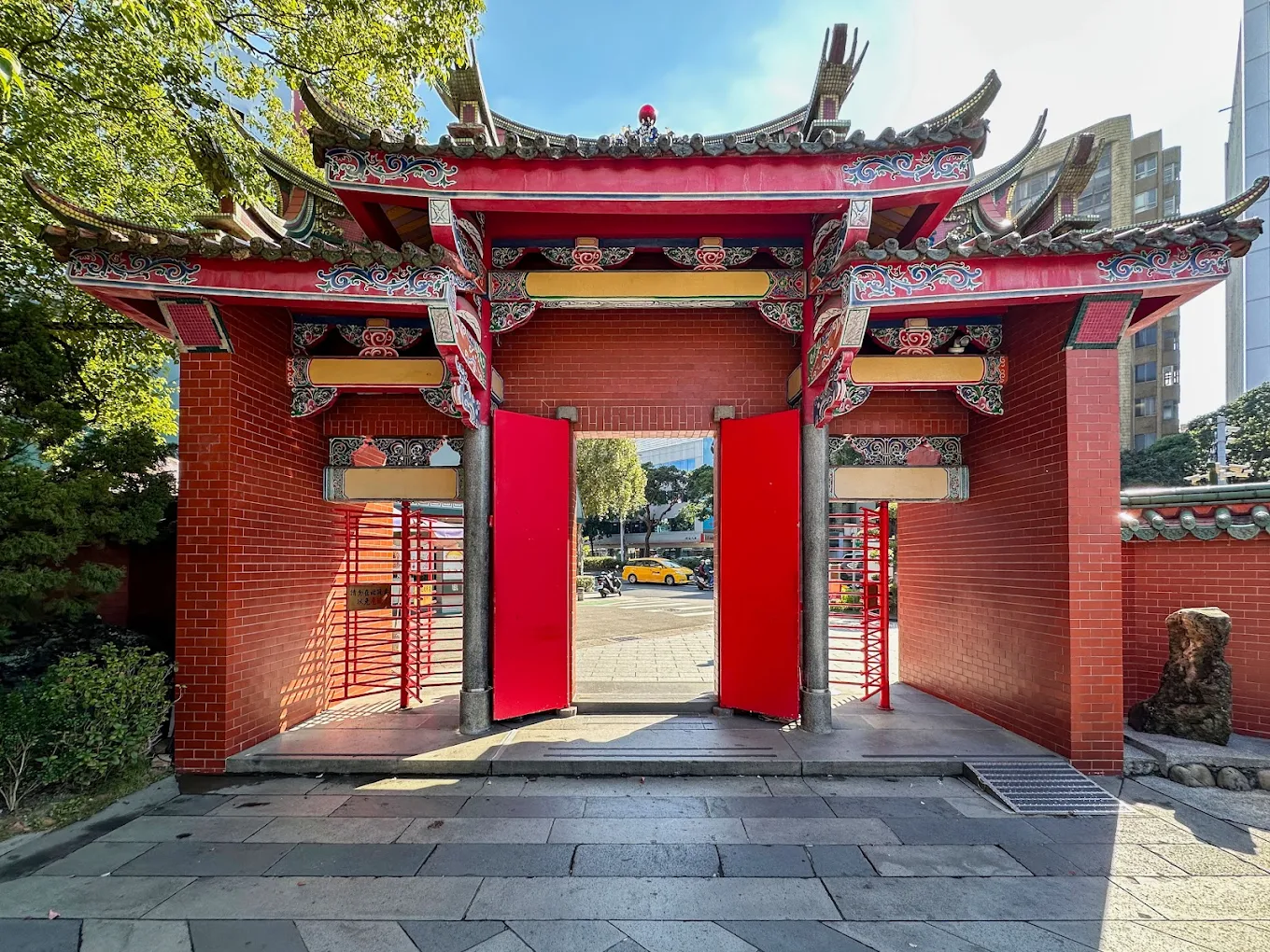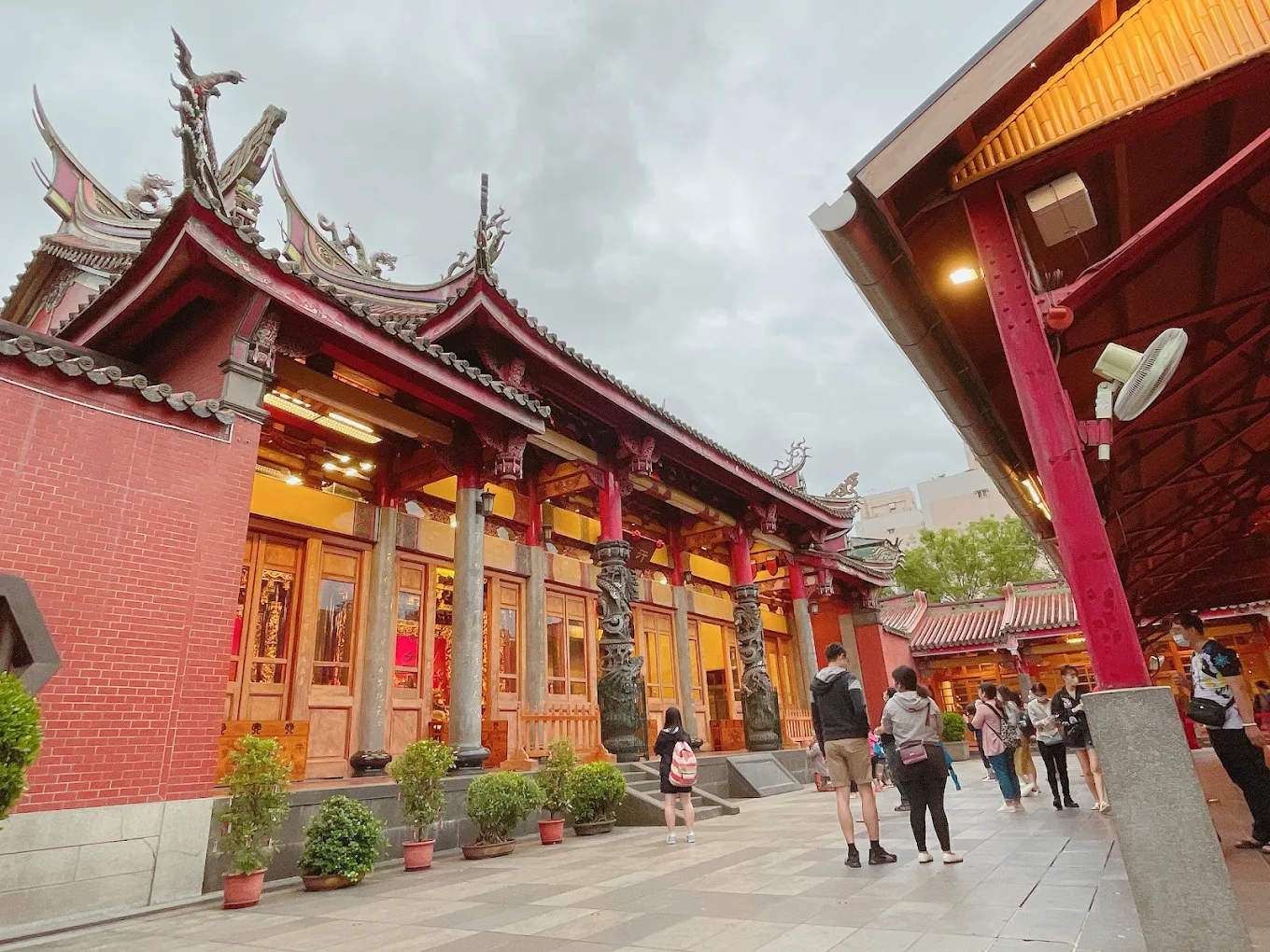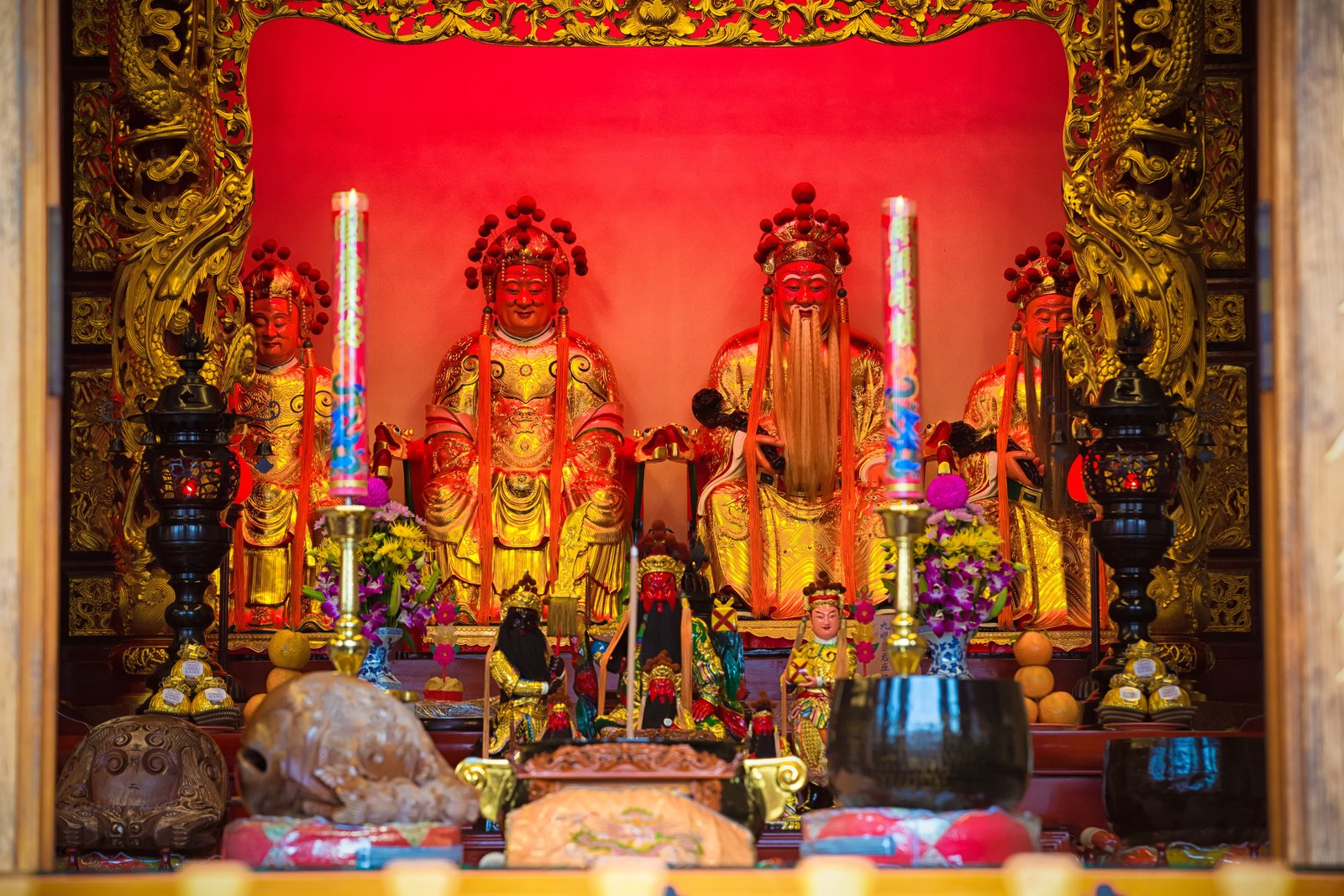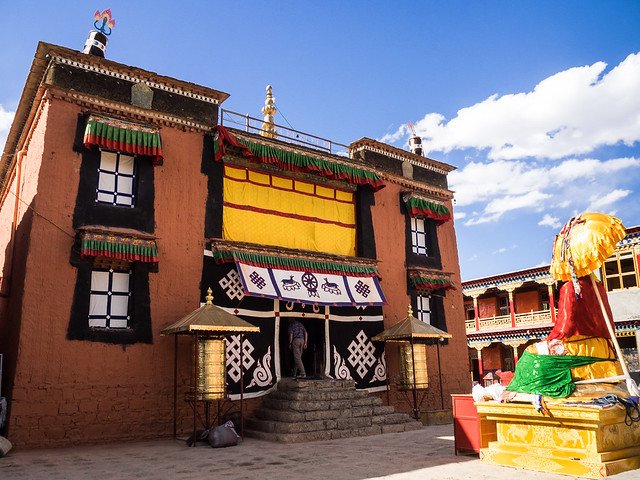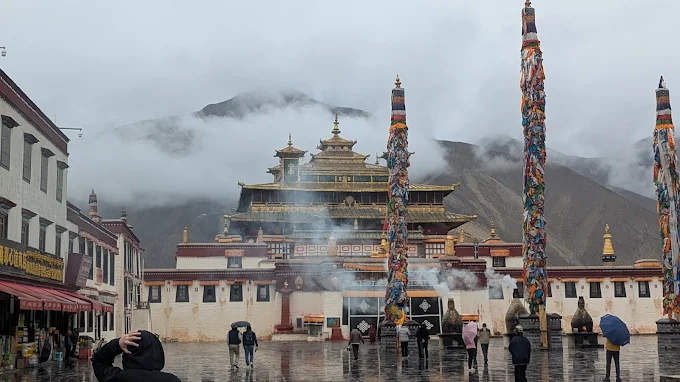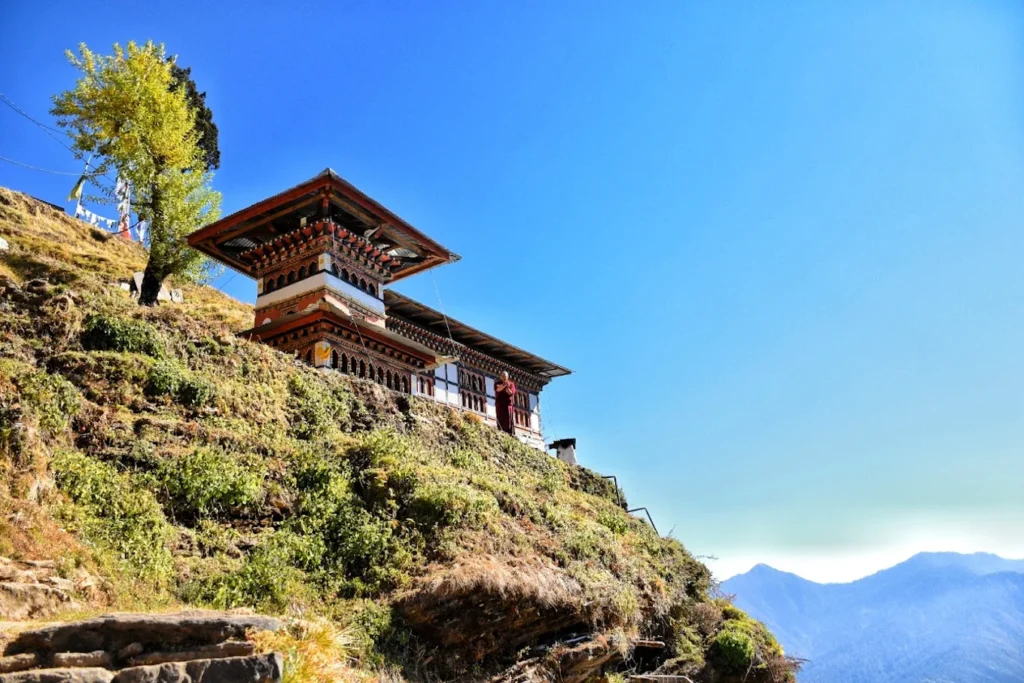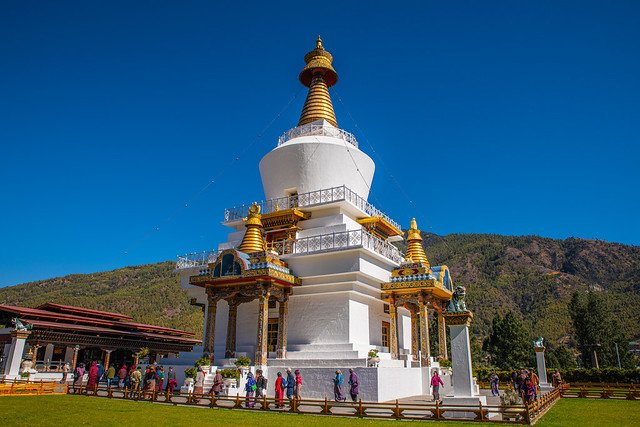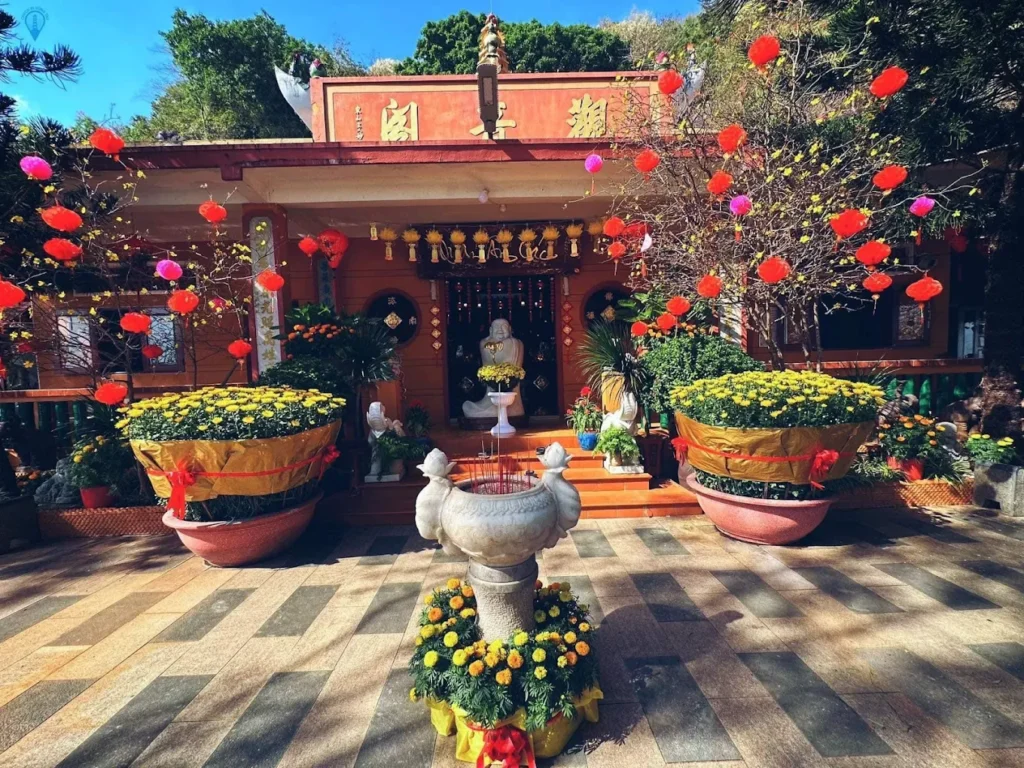Xingtian Temple: The Fujianese Citadel of Loyalty in Taipei’s Zhongshan District
In Taipei’s Zhongshan District, the air hums with the clink of jiaobei [divination blocks] and the warm scent of sandalwood incense swirling through Xingtian Temple’s bustling courtyard. Founded in 1967, this Taiwanese folk temple, rooted in Taoist and Confucian traditions, honors Guan Yu [Guān Yǔ], the god of war and commerce, revered for his loyalty and prosperity. Guan Yu, a 3rd-century general deified in Chinese folklore, embodies martial valor and business acumen, his 2-meter red-faced statue commanding reverence in the main hall. The temple’s sleek, modern design, with red-tiled roofs and golden dragon reliefs, contrasts Longshan’s ornate pillars and Taipei Confucius Temple’s minimalist serenity. Devotees, from merchants to students, offer incense for success, their prayers echoing under arched eaves. Xingtian Temple invites cultural travelers to explore Taipei’s commercial heart, where loyalty and prosperity intertwine along Minquan East Road.
Overview and Significance
Introduction to Xingtian Temple
Xingtian Temple, set in Taipei’s vibrant Zhongshan District, is a dynamic hub of Taiwanese folk religion, blending Taoist harmony and Confucian ethics. Established in 1967 by Fujianese devotees, it centers on Guan Yu, the god of war and commerce, whose loyalty inspires merchants and students alike. Taiwanese folk religion, a syncretic faith, integrates Taoist balance, Confucian duty, and local traditions, fostering prosperity and community. The temple’s golden dragon reliefs, distinct from Baoan’s medicinal murals or Taipei Confucius Temple’s scholarly stonework, symbolize wealth and protection. For cultural travelers, Xingtian Temple offers a vivid portal into Taipei’s commercial and spiritual heritage.
Historical Journey
Built by Fujianese immigrants in response to Taipei’s post-war economic boom, Xingtian Temple was completed in 1968, reflecting modern Fujianese architecture. Unlike older temples like Longshan, it avoided damage during Japanese rule (1895–1945) but faced urban rezoning challenges in the 1970s. A 1990 renovation by architect Li Ming-tsung modernized its facilities, adding a library for Taoist texts. Designated a cultural heritage site in 2005, Xingtian Temple’s history, verified by temple records, underscores its role as a modern spiritual anchor, drawing travelers to explore its legacy.
Cultural Significance
Xingtian Temple anchors Zhongshan’s commercial identity, hosting festivals like Guan Yu’s birthday on the 13th day of the fifth lunar month, where dragon dances and incense offerings fill the courtyard. The Zhongyuan Festival [Hungry Ghost Festival], a Taoist rite to honor spirits, features rice offerings, contrasting Taipei Confucius Temple’s modest rites. The temple attracts Southeast Asian merchants seeking prosperity blessings, fostering global ties. Its role in Taipei’s business community, offering rituals for success, makes Xingtian Temple a cultural beacon for travelers exploring Taipei’s heritage.
Unique Legacy
Xingtian Temple’s focus on Guan Yu, symbolizing loyalty and commerce, sets it apart from Longshan’s syncretism or Baoan’s healing ethos. Its golden dragon reliefs, reflecting Fujianese prosperity motifs, contrast Taipei Confucius Temple’s scholarly restraint. Philosophically, the temple embodies Taoist harmony and Confucian loyalty, offering travelers insights into Taiwan’s commercial spirituality. Its modern design, tied to Fujianese merchant traditions, distinguishes Xingtian Temple as a citadel of prosperity in Taipei.
Community and Global Impact
Xingtian Temple unites Zhongshan’s merchants and residents through rituals and charity drives, with locals gathering in nearby Linji Park post-worship. Free Taoist workshops attract international visitors, particularly from Singapore and Malaysia. Its cultural preservation efforts, recognized by the Ministry of Culture, promote global appreciation of Taiwanese folk religion. Travelers can witness this vibrant community spirit, connecting with Xingtian Temple’s role in Taipei’s commercial landscape.
Historical Anecdotes
A 1970s merchant, blessed with business success after praying to Guan Yu, donated a golden amulet now displayed in the main hall, per temple archives. Another tale recounts Li Ming-tsung’s 1990 renovation, incorporating dragon reliefs to honor Fujianese heritage. During Taipei’s 1980s economic boom, the temple offered free rituals for struggling vendors, a legacy preserved in community records. These stories deepen Xingtian Temple’s allure for cultural explorers.
Social Role
Xingtian Temple hosts Taoist study groups and business workshops, fostering community education. Feasts during Guan Yu’s birthday, with rice dumplings shared under courtyard trees, reflect communal harmony. Its charity drives, supporting local vendors, embody Confucian duty, while its role in Taipei’s economic culture highlights its civic impact. Travelers can engage with these initiatives, experiencing Xingtian Temple’s commercial heartbeat.
Artistic Influence
The temple’s golden dragon reliefs have inspired Zhongshan’s artisans, appearing in local jewelry and textiles. Its 1990 renovation set a standard for modern Fujianese design, influencing Taipei’s temple architecture. Unlike Taipei Confucius Temple’s muted stonework, Xingtian’s vibrant reliefs draw art enthusiasts, offering travelers a visual journey through Taiwan’s commercial heritage.
From the merchant prayers of Xingtian Temple to its golden dragon reliefs, its history shapes a sanctuary of prosperity. Cultural travelers, stepping into the main hall, are invited to explore its architectural vibrancy and spiritual depth, where every incense curl tells a story of loyalty.
Architectural and Spiritual Features
Iconic Design
Xingtian Temple’s modern siheyuan layout, with a central courtyard, aligns on a north-south axis, symbolizing Taoist harmony. The main hall [zhèng diàn], with its red-tiled roof and golden dragon reliefs, gleams under Taipei’s sun, reflecting Fujianese prosperity motifs. Unlike Longshan’s ornate curves, the temple’s sleek design emphasizes functionality, with concrete beams and tiled facades. Traditional dovetail joints, verified by temple records, showcase craftsmanship, captivating travelers with vibrant elegance.
Key Structures
The temple includes the main hall, east and west wings, and a rear shrine for minor deities. The main hall, with a 9-kaijian façade, enshrines Guan Yu’s statue, while wings house Taoist libraries. A drum tower adds rhythmic beats, and a tree-lined courtyard fosters calm. This modern design, distinct from Taipei Confucius Temple’s minimalism, invites reflection at Xingtian Temple.
Worshipped Statues/Deities
The main hall enshrines Guan Yu [Guān Yǔ], the god of war and commerce, a 3rd-century general deified for loyalty and business acumen. His 2-meter red-faced statue, wielding a halberd, embodies martial valor and prosperity, guiding devotees to success, a core Taiwanese folk belief verified by sectarian records. Other deities include:
- Mazu: Goddess of the sea, her 1.5-meter statue protects merchants.
- Wenchang Dijun: God of literature, his 1.4-meter statue aids students.
- Fude Zhengshen: God of wealth, his 1.3-meter statue draws entrepreneurs.
- Yue Lao: God of love, his 1-meter statue supports romantic wishes.
These statues, verified by temple signage, offer travelers insights into Xingtian Temple’s commercial devotion.
Materials and Techniques
The temple uses concrete, teak, and porcelain. The main hall’s concrete pillars, painted red, support a tiled roof with porcelain dragon figurines. Teak altars, joined by dovetail techniques, ensure durability, while golden reliefs add vibrancy. These materials, verified by architectural studies, highlight Xingtian Temple’s modern Fujianese craftsmanship.
Signature Elements
The golden dragon reliefs, unique in Taipei, adorn the main hall, symbolizing prosperity and protection. Unlike Baoan’s phoenix murals or Taipei Confucius Temple’s scholarly stonework, Xingtian’s reliefs reflect commercial aspirations, verified by art records. Their golden glow at dusk draws photographers, enhancing Xingtian Temple’s vibrant appeal for travelers.
Lesser-Known Features
Calligraphic boards in the east wing quote Taoist proverbs, while the courtyard’s porcelain incense burner, etched with dragons, hums with offerings. Roof figurines, distinct from Longshan’s ornate tiles, offer subtle beauty. These details, verified by temple guides, invite travelers to discover Xingtian Temple’s understated artistry.
Preservation Efforts
Post-1990 renovations reinforced concrete pillars, with community-funded roof repairs in 2015. A 2020 initiative reduced incense use to protect air quality, per Taiwan’s Environmental Agency. These efforts ensure Xingtian Temple’s longevity, welcoming future travelers to its vibrant halls.
Environmental Integration
The temple’s fēng shuǐ, a Mandarin concept of spatial harmony aligning buildings with natural energy flows, guides its north-facing entrance to harmonize with Zhongshan’s landscape, channeling prosperity. Tree-lined courtyards and stone paths create a calm oasis, their shade fostering reflection. This harmony, rooted in Fujianese traditions, captivates travelers amidst Taipei’s urban bustle.
Artisan Narratives
Architect Li Ming-tsung, overseeing the 1990 renovation, incorporated golden dragon reliefs to honor Fujianese merchants, as noted in temple archives. A painter’s account describes crafting reliefs by lamplight, reflecting prosperity motifs. These stories enrich Xingtian Temple’s allure for art enthusiasts exploring its craftsmanship.
Symbolic Details
Red pillars signify prosperity, while dragon reliefs denote protection, reflecting Guan Yu’s commercial ethos. Unlike Taipei Confucius Temple’s scholarly motifs, Xingtian’s symbols emphasize wealth, offering philosophical depth verified by art studies. The open courtyard fosters openness to success, inviting traveler reflection.
Landscape Integration
The tree-lined courtyard, with stone paths, fosters a meditative ambiance, contrasting Zhongshan’s urban energy. Positioned near Linji Park, the temple ties to Zhongshan’s commercial history, offering travelers an environmental and cultural synergy distinct from Baoan’s medicinal setting.
As the golden dragon reliefs of Xingtian Temple gleam, its architecture sets the stage for its vibrant rituals. Cultural travelers, moving from the main hall’s statues to merchant prayers, can immerse themselves in the practices that define this citadel of prosperity.
Rituals and Practices
Daily Sacred Rites
Each dawn, monks light candles in the main hall, their glow illuminating Guan Yu’s statue. Devotees offer incense at the courtyard’s porcelain burner, its smoke mingling with drum beats. Daily Taoist chants, at 6:00 AM, 8:00 AM, and 5:00 PM, fill Xingtian Temple with rhythmic prayers, drawing travelers into its commercial rhythm.
Unique Practices
Worshippers cast jiaobei [divination blocks] to seek Guan Yu’s guidance for business, a Fujianese rite verified by temple guides. At his altar, devotees offer red envelopes with business plans, casting jiaobei thrice for approval. Successful throws earn a blessed talisman, distinct from Taipei Confucius Temple’s scholarly rites, captivating entrepreneurial travelers at Xingtian Temple.
Festival Traditions
Guan Yu’s birthday, on the 13th day of the fifth lunar month, transforms Xingtian Temple with dragon dances and incense offerings, their aroma filling the air. The Zhongyuan Festival [Hungry Ghost Festival], honoring spirits, features rice dumplings shared under courtyard trees, contrasting Longshan’s lavish feasts. These ceremonies, verified by temple schedules, invite travelers to join Xingtian Temple’s vibrant celebrations.
Visitor Engagement
Travelers can join incense offerings, placing sticks at Guan Yu’s altar with volunteer guidance. Free guided tours explain jiaobei casting and Taoist chants, allowing respectful participation. These experiences, verified by tourism boards, immerse cultural travelers in Xingtian Temple’s commercial traditions, fostering a deeper connection.
Spiritual Community Roles
Monks lead chants, while lay practitioners [jūshì], devotees balancing secular and Taoist study, assist with rituals and workshops, verified by temple records. Lay practitioners organize business seminars, bridging spiritual and commercial life. Their roles offer travelers insights into Xingtian Temple’s role in Taipei’s entrepreneurial spirit.
Interfaith Connections
Xingtian’s Taoist focus, with Confucian loyalty via Guan Yu, integrates subtle Buddhist influences during the Zhongyuan Festival. Unlike Longshan’s broad syncretism, Xingtian Temple emphasizes commercial spirituality, fascinating travelers exploring Taiwan’s pluralistic faith through its prosperity-driven lens.
Ritual Symbolism
Red envelopes at Guan Yu’s altar symbolize prosperity, their vibrant hue reflecting success. Dragon-shaped incense burners denote protection, verified by sectarian records. These symbols, distinct from Baoan’s healing motifs, deepen Xingtian Temple’s rituals, offering travelers philosophical reflections on wealth and loyalty.
Seasonal Variations
Guan Yu’s birthday in summer features dragon dances, while the Zhongyuan Festival in autumn emphasizes spirit offerings. Lunar New Year brings drum ceremonies for renewal. These shifts, verified by temple schedules, create varied experiences for travelers visiting Xingtian Temple across seasons.
Monastic/Community Life
Monks meditate at 5:00 AM, while lay practitioners lead evening business workshops. Merchants and youth maintain the temple’s grounds, their chatter filling Linji Park post-rituals. This vibrant life, documented in community records, invites travelers to witness Xingtian Temple’s role as Taipei’s commercial heart.
From the merchant chants of Xingtian Temple, cultural travelers can transition to practical tips for experiencing its rituals. The temple’s prosperous energy, paired with Zhongshan’s bustling streets, offers a seamless blend of spiritual and commercial exploration.
Visitor Information
Navigating to Xingtian Temple
Xingtian Temple lies in Zhongshan District, a 5-minute walk from Xingtian Temple MRT Station. Exiting via Exit 3, travelers pass Linji Park, where locals jog under pines. The temple’s red-tiled roof emerges along Minquan East Road, lined with coffee shops and boutiques, their aromas guiding visitors to Xingtian Temple’s vibrant courtyard.
Address of Xingtian Temple
The temple’s full address is No. 109, Section 2, Minquan East Road, Zhongshan District, Taipei City, Taiwan. This central location, verified by Taipei’s Tourism Bureau, places Xingtian Temple in Zhongshan’s commercial core, accessible for travelers exploring Taipei’s heritage.
Visiting Hours and Etiquette
Xingtian Temple opens daily from 6:00 AM to 10:00 PM, with extended hours during Guan Yu’s birthday. Visitors should wear modest clothing, covering shoulders, and silence phones to respect devotees. Bowing at the main hall entrance, per temple guidelines, ensures travelers blend into Xingtian Temple’s spiritual atmosphere.
Transport Options
The Taipei MRT Blue Line’s Xingtian Temple Station (Exit 3) offers the easiest access, a 5-minute walk away. Zhongshan Station, 10 minutes south, serves multiple lines, while buses like Route 63 stop at Minquan East Road. Taxis or Uber, familiar with “Xingtian Temple” in Zhongshan, provide convenience. These options, verified by Taipei Metro, suit varied traveler needs.
Accessibility and Safety
Xingtian Temple offers wheelchair ramps at the main entrance and flat courtyard paths, with staff assistance for mobility-impaired visitors, per tourism board records. Minquan East Road’s moderate traffic requires caution, and travelers should stay hydrated in Taipei’s humidity, ensuring a safe visit to Xingtian Temple.
Amenities and Surroundings
On-site restrooms and shaded benches provide comfort, while nearby coffee shops offer Taiwanese brews. Songjiang Road, a 7-minute walk, serves noodle dishes and bubble tea, their scents wafting through the air. These amenities, verified by local guides, enhance the sensory experience around Xingtian Temple.
Immersive Visitor Tips
- Art Lovers: Capture the golden dragon reliefs at dusk, when they glow vibrantly.
- Meditators: Sit by the courtyard trees during evening chants, letting drum beats calm the mind.
- History Buffs: Join a free tour to learn about the 1990 renovation and economic boom.
- Festival Enthusiasts: Visit on the 13th day of the fifth lunar month for dragon dances.
Cultural Immersion Opportunities
Travelers can join incense offerings, placing sticks at Guan Yu’s altar with volunteer guidance, their scent filling the air. Participating in jiaobei casting, with explanations, offers a hands-on rite. Evening business workshops, open to visitors, teach Taoist prosperity principles, fostering connection. These activities, verified by temple schedules, immerse travelers in Xingtian Temple’s commercial traditions.
Nearby Cultural Experiences
Songjiang Road, a 7-minute walk, offers boutique shops, contrasting Xingtian’s spiritual vibrancy. Taipei Confucius Temple, 15 minutes away, provides scholarly serenity, distinct from Xingtian’s commercial focus. Taipei Fine Arts Museum, a 10-minute walk, showcases modern Taiwanese art. These sites, verified by Taipei’s Tourism Bureau, enrich Zhongshan’s cultural tapestry.
Photography Tips
Photograph the golden dragon reliefs at sunset, their glow contrasting the red roof, using a wide-angle lens. Capture the incense burner during rituals, its smoke weaving patterns, but avoid flash to respect devotees. Guan Yu’s statue, lit by candles, offers striking shots, per local photographers, ensuring travelers document Xingtian Temple’s beauty respectfully.
Offering incense at Xingtian Temple opens a window to its prosperous philosophy. Cultural travelers, having joined rituals and explored Zhongshan’s lanes, can reflect on the temple’s spiritual and commercial significance, rooted in Fujianese loyalty.
Cultural and Spiritual Insights
Religious Philosophy
Xingtian Temple’s Taoist and Confucian blend emphasizes harmony and loyalty. Guan Yu, the god of war and commerce, embodies Confucian duty and Taoist balance, guiding devotees to prosperity and integrity. Unlike Taipei Confucius Temple’s scholarly focus, Xingtian’s commercial spirituality resonates with Taipei’s business culture, verified by sectarian councils, offering travelers a lens into its vibrant ethos.
Environmental Spirituality
The temple’s feng shui alignment, with its north-facing entrance, harmonizes with Zhongshan’s landscape, channeling prosperity. Tree-lined courtyards and stone paths create a calm retreat, their shade fostering reflection. This environmental connection, rooted in Fujianese traditions, captivates travelers seeking balance amidst Taipei’s urban energy.
Artistic Symbolism
Golden dragon reliefs symbolize prosperity, reflecting Guan Yu’s commercial ethos. Red pillars denote strength, verified by art studies, contrasting Longshan’s protective motifs. These symbols deepen Xingtian Temple’s appeal, offering travelers philosophical reflections on wealth and loyalty.
Community Resilience
Community-funded renovations post-1990, including 2015 roof repairs, reflect Confucian duty. Stories of merchants donating talismans during economic downturns, preserved in archives, highlight Zhongshan’s resilience. Travelers witness this spirit in daily rituals, where devotees maintain Xingtian Temple with care.
Environmental Stewardship
Reduced incense use since 2020, protecting air quality, aligns with Taoist harmony, per Taiwan’s Environmental Agency. Tree plantings, supported by rainwater systems, enhance sustainability. These efforts inspire travelers to reflect on Xingtian Temple’s eco-conscious spirituality.
Meditative/Contemplative Practices
Morning Taoist chants, led by monks, focus on Guan Yu’s loyalty, with participants meditating under courtyard trees. Evening workshops, open to visitors, teach prosperity principles, fostering mindfulness. These practices, verified by temple schedules, offer travelers serene moments in Xingtian Temple’s vibrant heart.
Cultural Narratives
A legend tells of a vendor saved from bankruptcy after praying to Guan Yu, donating a jade talisman. Another recounts Li Ming-tsung’s dragon reliefs, honoring Fujianese merchants. These tales, preserved in oral histories, enrich Xingtian Temple’s allure for story-seeking travelers.
Historical Context
Xingtian’s 1967 founding reflects Taipei’s economic boom, driven by Fujianese merchants. Its role in supporting vendors during the 1980s highlights Zhongshan’s commercial resilience. This context, verified by academic journals, deepens travelers’ understanding of Xingtian Temple’s place in Taipei’s history.
Modern Cultural Connections
Xingtian Temple thrives in modern Taipei, with youth sharing rituals on social media, boosting global reach. Guan Yu’s birthday draws entrepreneurs crafting talismans, while Southeast Asian visitors post prosperity prayers. These connections, verified by tourism data, highlight Xingtian Temple’s role in Taipei’s commercial vibrancy.
From the prosperous philosophy of Xingtian Temple to its modern vitality, its insights inspire exploration. Cultural travelers, enriched by its commercial legacy, are beckoned to experience its golden reliefs and devotional heart, a journey into Taipei’s thriving soul.
Why You Have to Visit
Xingtian Temple, with its golden dragon reliefs and Guan Yu’s commanding presence, is Taipei’s citadel of loyalty, weaving Fujianese commerce into Zhongshan’s bustling streets. Its Taoist-Confucian blend offers a vibrant contrast to Taipei Confucius Temple’s scholarship or Baoan’s healing, embodying Taiwan’s entrepreneurial spirit. Built and sustained through economic booms, Xingtian Temple pulses with community vitality, its rituals and workshops fostering prosperity. For cultural travelers, visiting Xingtian Temple means joining incense offerings, casting jiaobei for success, or exploring its modern design, each moment steeped in Taipei’s history. Discover this prosperous sanctuary to connect with Taiwan’s past and present, where every dragon relief tells a story of loyalty and wealth.
